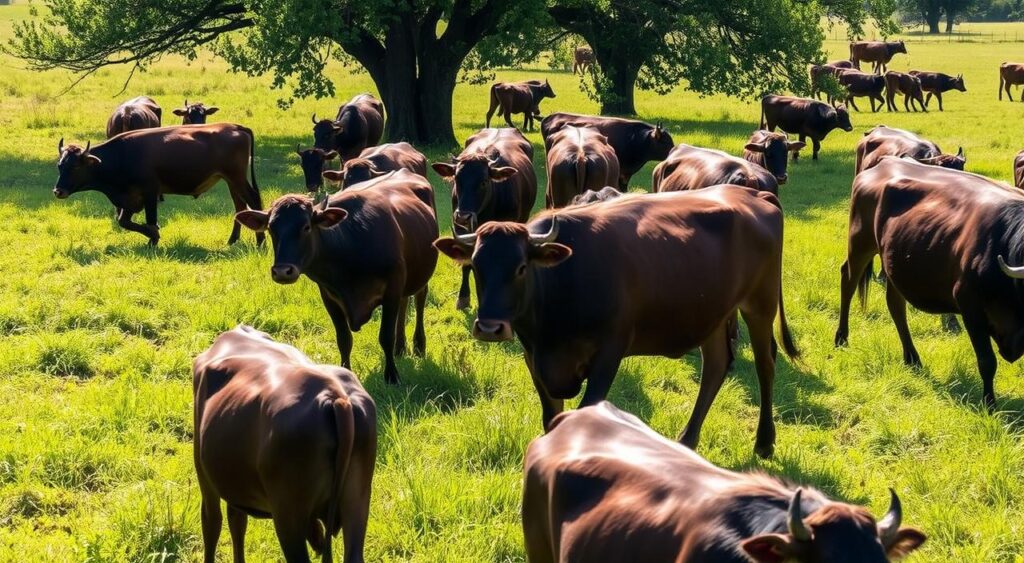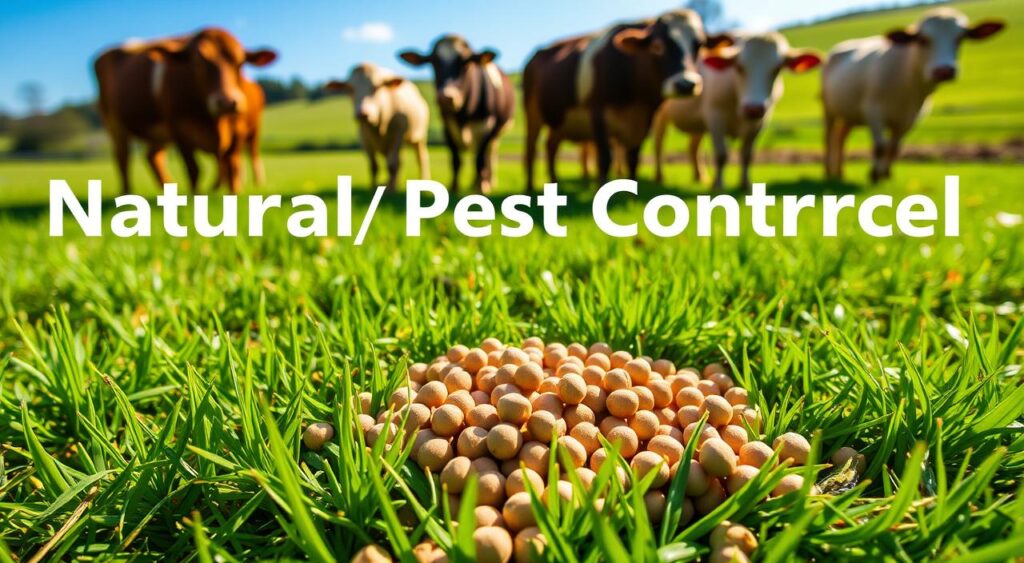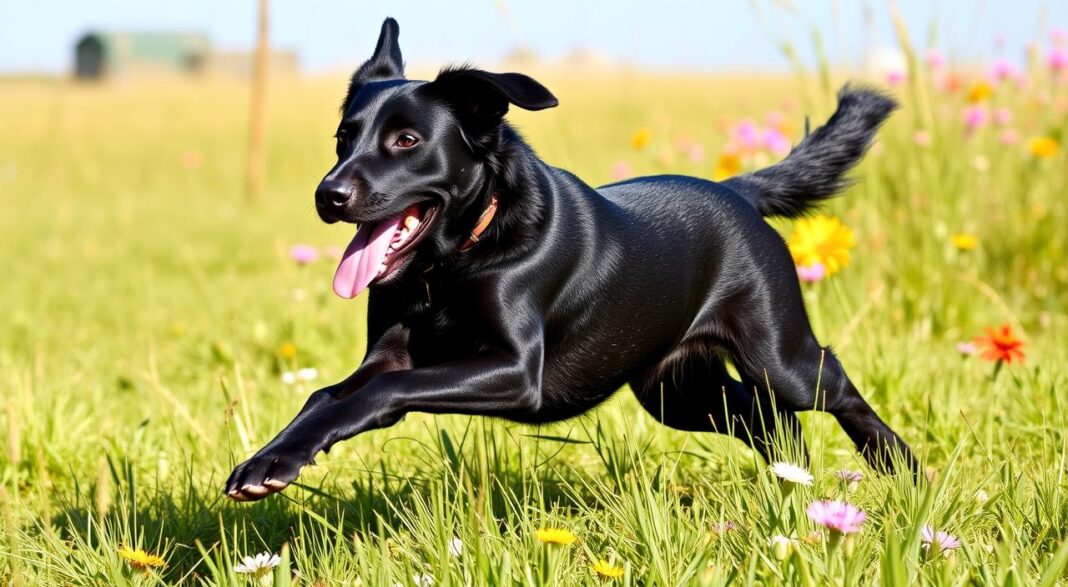Cattle farmers struggle with pesky flies that harm their livestock. These flies not only bother cows but also cost a lot of money. Researchers are looking into natural ways to fight these pests, including cow diet options.
Blood-sucking flies, like stable flies, are a big problem for cattle. They cost U.S. cattle farmers $2.4 billion each year. Traditional methods, like insecticides, don’t work well against these tough flies.
Can Cows Eat Catnip? : Now, catnip is being considered as a solution. This herb, known for its effects on cats, is surprisingly effective against these flies. Catnip oil pellets can repel flies in cattle feedlots in just minutes. The effect lasts about three hours.
Using catnip as a natural fly repellent could change how we manage pests in livestock. Scientists are working to make catnip oil last longer. This could protect cows in feedlots and pastures for even longer.
Key Points
- Catnip shows promise as an effective fly repellent for cattle
- Blood-sucking flies cause billions in annual losses to the cattle industry
- Catnip oil pellets repel flies quickly and last for hours
- Researchers are developing long-lasting catnip-based repellents
- Natural pest control methods may reduce reliance on chemical insecticides
Understanding Catnip and Its Effects
Catnip, a plant known for its unusual effects on felines, has caught the eye of farmers. They see it as a possible way to keep pests away from their cattle. This herb’s unique properties make it an intriguing option for farmers looking for new ways to protect their livestock.
What is catnip?
Catnip, scientifically known as Nepeta cataria, is a perennial herb from the mint family. It’s well-known for its effects on cats, but it might also help with cattle care. Its strong scent and natural compounds make it a promising candidate for unusual animal feed and pest control.
Chemical composition of catnip
The main part of catnip is nepetalactone, an organic compound. This essential oil is a powerful insect repellent. It could be very useful for protecting cattle. When hydrogenated, nepetalactone becomes even more effective, beating DEET in repelling stable flies.
Effects on felines
Cats react strongly to catnip, but its effects on cattle are different. Research shows that catnip oil keeps horn flies from biting cattle. This could be a game-changer for natural pest control in livestock management. It might even help reduce the $1 billion annual loss from horn flies in North America.
Exploring catnip’s effects on cattle is a new way to tackle pest problems in farming. By using this plant, farmers could find a sustainable and cost-effective way to protect their herds from harmful insects.
The Importance of Proper Cattle Nutrition

Good nutrition is key for healthy cattle and better farm productivity. How cattle graze affects their health and work. A balanced diet keeps them strong, growing well, and producing quality meat or dairy.
Different cattle need different diets based on their age, breed, and use. Managing pastures well is important for feeding them right. Rotating grazing keeps the pasture healthy and stops overgrazing, helping farms stay green.
Minerals and vitamins are often added to cattle food to meet their needs. This is true when the pasture is not good or when the weather is tough.
| Nutrient | Function | Source |
|---|---|---|
| Protein | Muscle growth, milk production | Legumes, soybean meal |
| Carbohydrates | Energy | Grass, corn |
| Calcium | Bone health, milk production | Limestone, alfalfa |
| Phosphorus | Bone growth, metabolism | Grain, mineral supplements |
Right nutrition does more than keep cattle healthy. It also helps control pests. Well-fed cattle fight off parasites and diseases better. This shows how important nutrition, grazing, and managing the herd are together.
Common Pests Affecting Cattle: Horn Flies and Stable Flies
Cows are at risk of pest infestations due to their grazing habits. Horn flies and stable flies are major threats to their health and productivity. These pests are a big problem for farmers in the United States.
Economic impact on the cattle industry
The financial loss from these flies is huge. Stable flies alone cost U.S. cattle producers over $2 billion each year. This loss is due to less milk and weight gain in affected herds.
| Pest Type | Annual Economic Loss |
|---|---|
| Horn Flies | $1 billion |
| Stable Flies | $2 billion |
Health risks for cattle
These pests do more than just bother cows. They cause serious health problems that affect the whole herd. Fly bites can lead to stress, weight loss, and less milk. This hurts the herd’s health and productivity.
Farmers are looking for natural ways to fight these pests. Some ask, can cows eat catnip as a repellent? While research is ongoing, traditional methods are also key. These include keeping living spaces clean, managing manure well, and using insecticides when needed.
Traditional Pest Control Methods for Cattle
Farmers have always struggled to keep pests away from their livestock. Bloodsucking flies cost the cattle industry a lot of money each year. These pests harm the health of cows and horses, leading to serious problems.

Most farmers use synthetic pesticides to fight pests. These chemicals are sprayed or given to the animals. But, over time, flies have become resistant to these treatments.
There’s another way to control pests: removing places where they breed. This method stops flies from multiplying. But, it’s hard work and expensive for big farms.
| Control Method | Advantages | Disadvantages |
|---|---|---|
| Synthetic Pesticides | Quick action, Wide coverage | Increasing resistance, Environmental concerns |
| Cultural Control | Environmentally friendly, Long-term effectiveness | Labor-intensive, Time-consuming |
| Safe Plants (e.g., Catnip) | Natural, Low toxicity | Limited research on large-scale application |
Farmers are looking for better ways to protect their animals. They’re interested in using safe plants like catnip. Catnip might help keep flies away naturally, keeping cows healthy and well-nourished.
Can Cows Eat Catnip?
Farmers are always looking for new ways to keep their cattle healthy and productive. They wonder if cows can eat catnip as a natural way to keep pests away. Catnip is known to affect cats, but can it help cows too?
Safety Considerations

It’s important to check if catnip is safe for cows before adding it to their diet. Catnip is in the mint family and is safe for most mammals. But, cows have special digestive systems. So, we need to be careful when introducing new foods.
There’s not much research on cows eating catnip. So, we should start with small amounts and watch for any bad reactions.
Potential Benefits
Catnip might help keep pests away from cows. Studies show that catnip oil is better at keeping flies away than DEET. This means catnip could be good for cows in two ways: it could give them nutrients and keep pests off.
| Aspect | Catnip | DEET |
|---|---|---|
| Effectiveness against stable flies | Highly effective | Less effective |
| Natural vs. Synthetic | Natural | Synthetic |
| Potential for cattle consumption | Possible | Not suitable |
Even though there’s not much research on catnip for cows, its ability to repel pests is interesting. Farmers thinking about using catnip or catnip oil for their cows should talk to vets. This way, they can make sure it’s safe and works well.
Catnip as a Natural Insect Repellent for Cattle
Catnip is being looked at as a natural way to keep pests away from cattle. It’s a safe option for cows and could replace harmful chemicals. Horn flies can cut milk production by up to 20%, causing big losses for farmers.

Effectiveness against flies
Studies show catnip works well against flies that bother cattle. It keeps these pests away 99% of the time. This is great news for farmers worried about flies becoming resistant to chemicals.
Comparison to synthetic pesticides
Catnip is safer than chemical pesticides. It’s better for the environment and doesn’t harm cows. Using catnip helps farmers care for their animals and the planet.
| Aspect | Catnip-based Repellents | Synthetic Pesticides |
|---|---|---|
| Effectiveness | 99% effective against flies | Varying effectiveness due to resistance |
| Environmental Impact | Minimal | Potential harm to ecosystems |
| Safety for Cattle | Non-toxic | Potential side effects |
| Resistance Development | Low risk | High risk of pest resistance |
Using catnip can help farmers cut down on losses from pests. It keeps cows healthy and productive. This natural method is a good choice for managing pests in cattle farming.
Other Botanical Compounds for Cattle Pest Control
Farmers are looking into safe plants for cows as natural pest control. These plants not only feed the cows but also protect them from pests. Recent studies have shown that plant-based repellents can fight stable flies well. Stable flies are a big problem for cattle, causing a lot of economic loss.
Neem oil, from the neem tree, is becoming popular for fighting insects. Pyrethrum, from chrysanthemum flowers, is a strong natural pesticide. Mint and lemongrass essential oils also show promise in keeping pests away from cattle.

Catnip oil, known for attracting cats, is also good at keeping stable flies away. Studies show catnip oil can cut stable fly numbers in cattle feedlots by over 99%. It works for about 3 hours, making it a good short-term fix.
| Botanical Compound | Source | Effectiveness |
|---|---|---|
| Neem Oil | Neem Tree | High insecticidal properties |
| Pyrethrum | Chrysanthemum | Potent natural pesticide |
| Catnip Oil | Catnip Plant | 99% repellency for 3 hours |
| Mint Essential Oil | Mint Plants | Moderate repellent effect |
| Lemongrass Oil | Lemongrass | Effective insect repellent |
These plant-based compounds are a hopeful solution for managing pests in cattle farming. By using these safe plants, farmers can cut down on synthetic pesticides. This helps keep the herd healthy and productive.
Innovative Application Methods for Catnip-Based Repellents
Farmers are finding new ways to keep pests away from their cattle. They’re using catnip oil, which is safe for cows and good for their health. Let’s explore two exciting ways to use catnip-based repellents on farms.
Pellet Formulations

Scientists have made special pellets with catnip oil, soy, and wax. Farmers can spread these pellets in feedlots where cows eat. The pellets slowly release catnip oil, keeping flies away from the cows.
Automatic Sprayer Systems
Another cool idea is using automatic sprayers to put catnip oil on cows. These sprayers can work while farmers do other jobs. They spray a fine mist of catnip oil on the cows’ backs.
This keeps flies away all day long. Farmers like this method because it saves time and works well.
Both these methods help keep cows healthy without using harsh chemicals. They show how farms can use natural products like catnip oil to solve pest problems. As more farmers try these new ideas, we might see happier, healthier cows on farms across the country.
| Application Method | Ease of Use | Duration of Protection |
|---|---|---|
| Pellet Formulations | High | Long-lasting |
| Automatic Sprayer Systems | Very High | Daily application |
The Role of Fungi in Cattle Pest Management
Fungi are surprisingly important in managing pests in cattle. They offer a unique way to control pests through cattle grazing habits. Some fungi, like those in the Neotyphodium genus, live inside grasses that cattle eat. These fungi make compounds that fight off insect pests, making them an unusual animal feed with benefits.

Studies show that cattle eating fungus-rich grasses have fewer horn flies. This natural method could change how farmers manage their herds and pastures. By adding these fungal-rich grasses to cattle, farmers might use less chemical pesticides.
This method fits with the trend of sustainable pest management in livestock. It has both environmental and economic benefits. It helps address the estimated US$1.5 billion annual losses in livestock production due to filth fly pests.
- Fungal endophytes in grasses can reduce horn fly populations by up to 50%
- Selective grazing on these grasses could be a natural pest control method
- This approach supports sustainable and integrated pest management practices
As research goes on, fungi might play a big role in better cattle pest management. This could lead to healthier herds, better grazing habits, and more sustainable farming. It’s a step towards a greener and more effective way of farming.
Environmental and Health Benefits of Natural Pest Control
Natural pest control methods are great for keeping cows healthy and the environment safe. They cut down on the use of harmful synthetic pesticides. This helps protect the planet and stops pests from becoming resistant to treatments.
Studies have found that natural repellents from coconut fatty acids work better than DEET. These plant-based solutions keep away stable flies, ticks, and biting flies very well. They show over 90% repellency at low doses. This could change how we care for cows and other livestock.
Choosing natural pest control fits with the goal of making farming more sustainable. Unlike tobacco farming, which uses a lot of pesticides and harms the soil, herbal farming helps the environment. It keeps the soil healthy and supports biodiversity.
Using natural pest control helps make farms better places for animals and people. It lowers the risk of health problems from chemical exposure. As farming evolves, using safe plants and natural pest control will be key for a healthy farm and happy animals.




